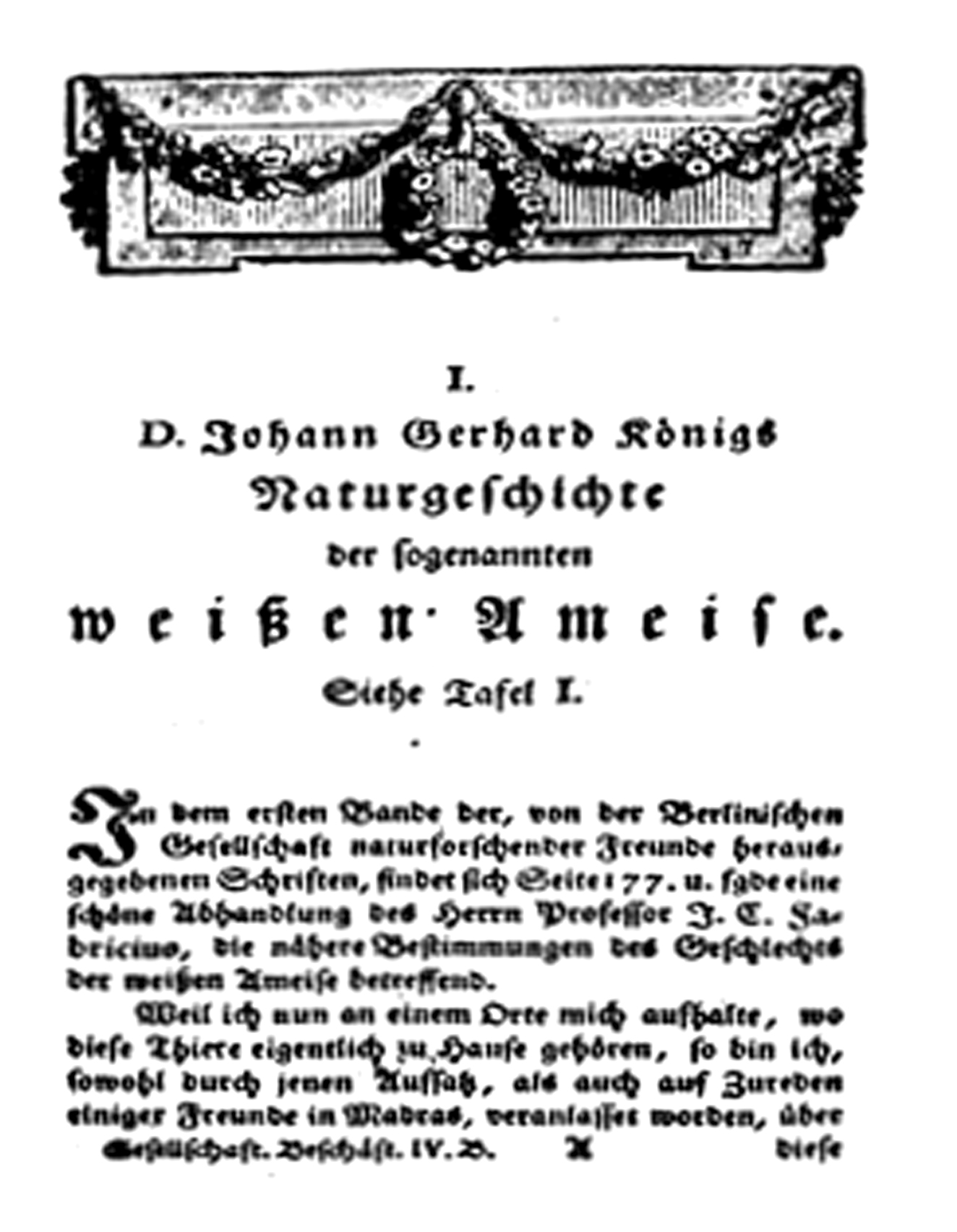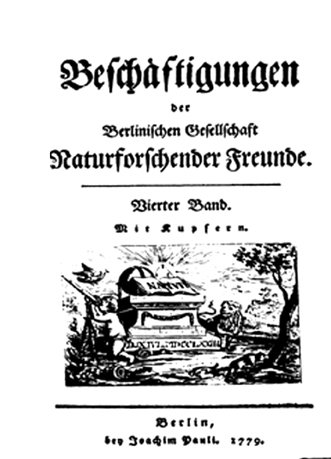– The first entomological paper from India

Page 1 of D(octor) Johann Gerhard Konig's article,
'Naturgeschichete der sogenannten weiben Ameise'.

Cover page of Volume 4 of Beschaftigungen der
Berlinischen Gesellschaft naturforschender Freunde,
1779.
Tranquebar’s missionaries included medical doctors employed by the Royal Danish Lutheran Mission (also known as the Tranquebar Mission, Halle Mission). Samuel Benjamin Cnoll (1705-1767), a surgeon from Halle (Germany), was employed in Tranquebar from 1732 to 1767. When Cnoll died in 1767, Johann Gerhard Konig (1728-1785), a surgeon trained in botany by Carolus Linnaeus (Uppsala, Sweden), succeeded him in 1768.
Konig gave up the Tranquebar Mission position to join the Court of the Nawab of Arcot in 1775. During his employment with the Nawab of Arcot, Konig travelled to the mountains north of Madras and to Ceylon collecting plants. Through the efforts of Joseph Banks, the most influential president of the Royal Society of London, Konig was offered the job of Naturalist with the English East India Company in 1778, with which he remained until his death in 1785. While travelling to Vizagapatam to meet Claud Russell, the brother of Patrick Russell, Konig contracted an enteric infection. William Roxburgh, then at Samalkot, treated Konig, but in vain. He is interred in Jaggandhapuram near Kakinada. Konig is remembered in India as an avid botanist for his extensive collections and determinations of different plants of southern India.
I was amazed to find that Konig had published a professional paper entitled ‘The Natural history of the so-called white ants – the termites’ (Naturgeschichte der sogenannten weiben Ameise) in the Beschaftigungen der Berlinischen Gesellschaft naturforschender Freunde (which can be crudely translated to read The Research Activities of the Berlin Society of the Friends of Nature) in Volume 4, 1779. As customary in the 18th century Germany, Konig’s paper is printed in the difficult to read Fraktur typefaces (the calligraphic hand of Latin letters of alphabets) (see images).
Today we know that termites are the master architects of the natural world. When we compare a termite to the size of an average human, the relative height of one termitarium (termite mound) would be as tall as a 180-storey building in human terms. They build termitaria using the soil mixed with their saliva. A system of channels and ducts circulates air through these mounds, which have porous walls. At the lower core of the termitarium are the living and working quarters. This area is the coolest and most insulated section of the mound. The royal chamber, which is the largest chamber in the nest, houses the queen and king. Below the royal chamber, the worker termites store food and care for the young termites. In some colonies, the workers tend gardens where fungi grow. The termites grow this fungus inside a comb, which is located in several pockets in the central section of the inner core of the mound.
Termites live on cellulose, the carbohydrate that builds plant material. The tunnels lead outward and branch into a network of passages that open to the outside. The insects make their trips to the outside at night, when it is cooler, and collect twigs, leaves, seeds and other vegetable food. The towers of the termite mounds act as turrets pushing the rising hot air, generated by the breaking down of the fecal comb by the fungus. Amazingly modified structures of the exteriors of termitaria occur throughtout the world, adapting to local environmental conditions. Woeful it is that we – humans – look with bias and contempt at these extraordinary natural engineers as pests.
In ‘The Natural history of the so-called white ants – the termites’, Konig refers to termites and termitaria he studied at a location east, southeast of Tanjore. He describes vividly the elegant structure of the termitaria and the biological details of these relentless social animals. His inspiration to write this article, he declares at the start of his article, comes from the previous work of Johan Christian Fabricius (1745-1808), a Danish Naturalist, whose writing on castes in European termites was published in Germany.
I was astounded to read many details in Koenig’s article published way back in 1779 that elegantly match with our present understanding of the termites and termitaria.
I am nearly cent per cent confident that this article of Konig is the first formal scientific paper in entomology from India. The next formal entomological paper was by James Kerr, a medical officer in the India Company’s Service, who published the paper entitled ‘Natural history of the insect which produces the gum lacca’. This was published in the Philosophical Transactions of the Royal Society of London in 1781.
Another feather to Madras’s cap – I am, of course, pleased!
|

